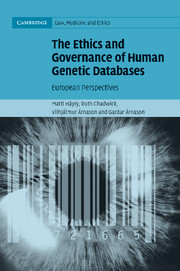Book contents
- Frontmatter
- Contents
- List of contributors
- 1 Introduction: some lessons of ELSAGEN
- Part I Background
- 2 On human genetic databases
- 3 American principles, European values and the mezzanine rules of ethical genetic databanking
- 4 The languages of privacy
- Part II Social concerns
- Part III Legal issues
- Part IV Ethical questions
- Part V Political considerations
- Part VI Conclusion
- Bibliography
- Index
2 - On human genetic databases
from Part I - Background
Published online by Cambridge University Press: 05 August 2012
- Frontmatter
- Contents
- List of contributors
- 1 Introduction: some lessons of ELSAGEN
- Part I Background
- 2 On human genetic databases
- 3 American principles, European values and the mezzanine rules of ethical genetic databanking
- 4 The languages of privacy
- Part II Social concerns
- Part III Legal issues
- Part IV Ethical questions
- Part V Political considerations
- Part VI Conclusion
- Bibliography
- Index
Summary
Human genetic databases have the primary purpose of providing data for research in human genetics and medicine. They combine health data and genetic data from a large population, and include in some cases genealogical information or lifestyle information.
The authors of this volume focus on four human genetic databases in as many countries: the Medical Biobank of Umeå in Sweden, deCODE's Health Sector Database in Iceland, the Estonian Genome Project and UK Biobank. To date only the first of the four has been established, but it has had serious operational problems. The Estonian Genome Project and UK Biobank are slowly progressing, but deCODE's plans to establish a health sector database appear to be on hold.
The Medical Biobank of Umeå is owned and operated by the University of Umeå and Västerbotten county council. The University and the county council founded together the company UmanGenomics, which is responsible for the commercial uses of the biobank. The biobank is based on a cohort study of cardiovascular disease and diabetes, which have a relatively high frequency in the county of Västerbotten. Since 1990 residents of Västerbotten county have been invited for a health check-up when they turn forty, fifty or sixty. They have been invited to donate blood samples to the biobank, which has resulted in a database with about 100,000 samples (about 70% donated by participants in the study, the rest donated by participants in other studies) which is growing by about 5,000 samples each year.
- Type
- Chapter
- Information
- The Ethics and Governance of Human Genetic DatabasesEuropean Perspectives, pp. 11 - 13Publisher: Cambridge University PressPrint publication year: 2007
- 1
- Cited by



